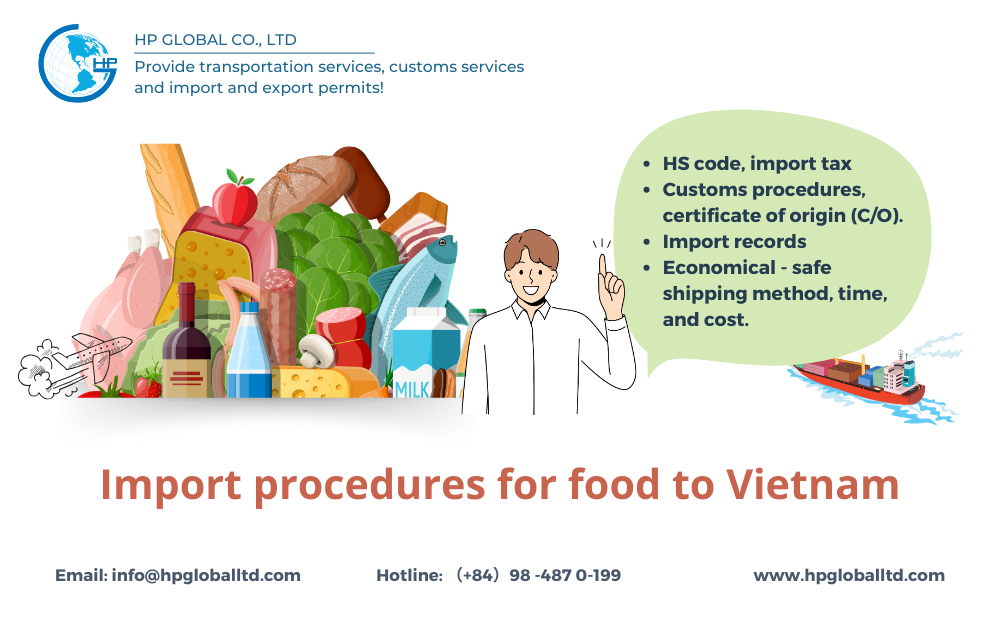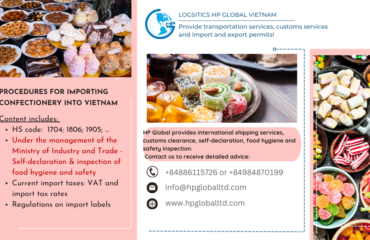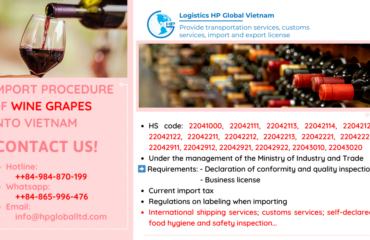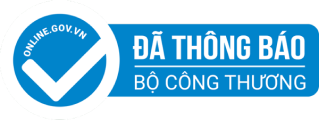Customs Procedures and Import Taxes for Food into Vietnam in 2025
Imported food products for business purposes in Vietnam are regulated by the Food Safety Law. The range of food products is extensive and falls under the jurisdiction of three ministries: the Ministry of Industry and Trade, the Ministry of Agriculture and Rural Development, and the Ministry of Health. This article on import procedures is a general overview in a series of articles about food, so we will focus on the general import principles for food products; how to determine which ministry governs a specific food product, and reference detailed articles to clarify specific products.
What are the special points to note about food import procedures to Vietnam?
Food products are subject to specialized management by three ministries: the Ministry of Health, the Ministry of Industry and Trade, and the Ministry of Agriculture and Rural Development. Therefore, when importing food products, the first step is to determine the HS code and then identify under which ministry’s jurisdiction the food product falls and according to which regulatory document.
Once it is determined which ministry manages the product and under which regulatory document, the procedures will be carried out according to the relevant regulations.
Imported food and related business activities in Vietnam are subject to the regulations of the Food Safety Law. In this article, HP Global discusses common aspects of importing food items falling under the jurisdiction of the Food Safety Law, while also providing references to customs procedures and import taxes for specific food products.
Regulatory Documents Related to Imported Food Safety
- Food Safety Law of 2010
- Decree No. 15/2018/ND-CP dated February 2, 2018, of the Government detailing the implementation of several articles of the Food Safety Law
- Circular No. 28/2021/TT-BYT dated December 20, 2021, of the Ministry of Health on the Issuance of the List of Food, Food Additives, and Packaging Materials that have been assigned Commodity Codes according to the Vietnamese Export and Import Commodity List for State Inspection of Food Safety for Imported Food
- Decision No. 1182/QD-BCT dated April 6, 2021, of the Ministry of Industry and Trade on the Issuance of the List of Imported Goods (with HS codes) subject to Specialized Inspection under the Responsibility of the Ministry of Industry and Trade
- Circular No. 01/2025/TT-BNNPTNT dated February 2, 2025, of the Ministry of Agriculture and Rural Development Issuing the HS Code Table for the List of Goods under the State Management Authority of the Ministry of Agriculture and Rural Development and the List of Exported and Imported Goods subject to Specialized Inspection in the field of Agriculture and Rural Development
Definition of food
The definition of food according to Article 2, Point 20, of the Food Safety Law is as follows: “Food is a product that humans consume in its raw or processed, prepared, and preserved forms. Food does not include cosmetics, tobacco, and substances used as pharmaceuticals.”
Here are some detailed definitions:
- Fresh Food: Food that has not undergone processing, including meat, eggs, fish, aquatic products, vegetables, tubers, fresh fruits, and other unprocessed foods. (Article 2, Point 21, Food Safety Law)
- Nutrient-Enhanced Food: Food supplemented with vitamins, minerals, and trace elements to prevent and remedy deficiencies in those substances for the health of the community or specific groups within the community. (Article 2, Point 22, Food Safety Law)
- Functional Food: Food used to support the body’s functions, promote comfort, enhance immunity, and reduce the risk of disease, including nutritional supplements, health-protecting foods, and medical nutritional foods. (Article 2, Point 23, Food Safety Law)
- Genetically Modified Food: Food with one or more components altered by genetic technology. (Article 2, Point 24, Food Safety Law)
- Irradiated Food: Food that has been irradiated with a radiation source to process and prevent the deterioration of the food. (Article 2, Point 25, Food Safety Law)
- Street Food: Food prepared for immediate consumption, typically sold through street vendors, street markets, public places, or similar venues. (Article 2, Point 26, Food Safety Law)
- Packaged Food: Food that is fully packaged and labeled, ready for direct sale for further processing or immediate consumption. (Article 2, Point 27, Food Safety Law)
Food Classification by Specialized Regulatory Authorities
The classification of products and product groups in the food sector, as well as related commodities, is carried out according to the regulatory authorities responsible for food safety as follows:
|
|
Note | Management Team (*) | |
| Under the management of the Ministry of Industry and Trade |
|||
| I | Beer |
|
|
| II | Alcohol, Spirits, and Alcoholic Beverages | Excluding fortified wine products managed by the Ministry of Health | Ministry of Industry and Trade |
| III | Beverages |
|
Ministry of Industry and Trade |
| IV | Processed Milk | Excluding nutrient-enhanced products and functional foods managed by the Ministry of Health | Ministry of Industry and Trade |
| V | Vegetable Oil | Ministry of Industry and Trade | |
| VI | Flour, Starch | Ministry of Industry and Trade | |
| VII | Cakes, Preserves, Candy | Ministry of Industry and Trade | |
| VIII | Utensils, Packaging Materials, and Containers for food during the production, processing, and business processes are within the assigned management scope. | Ministry of Industry and Trade | |
|
Under the management of the Ministry of Agriculture and Rural Development |
|||
| I | Cereals | Ministry of Agriculture and Rural Development | |
| II | Meat and meat products | Ministry of Agriculture and Rural Development | |
| III | Aquatic products and aquatic product derivatives (including amphibians) | Ministry of Agriculture and Rural Development | |
| IV | Vegetables, tubers, fruits, and products made from vegetables, tubers, and fruits | Ministry of Agriculture and Rural Development | |
| V | Eggs and egg products | Ministry of Agriculture and Rural Development | |
| VI | Raw fresh milk | Ministry of Agriculture and Rural Development | |
| VII | Honey and honey products | Ministry of Agriculture and Rural Development | |
| VIII | Genetically modified foods | Ministry of Agriculture and Rural Development | |
| IX | Salt | Ministry of Agriculture and Rural Development | |
| X | Spices | Ministry of Agriculture and Rural Development | |
| XI | Sugar | Ministry of Agriculture and Rural Development | |
| XII | Tea | Ministry of Agriculture and Rural Development | |
| XIII | Coffee | Ministry of Agriculture and Rural Development | |
| XIV | Cocoa | Ministry of Agriculture and Rural Development | |
| XV | Pepper | Ministry of Agriculture and Rural Development | |
| XVI | Cashews | Ministry of Agriculture and Rural Development | |
| XVII | Other agricultural food products | Ministry of Agriculture and Rural Development | |
| XVIII | Utensils, packaging materials, and containers for food during production, processing, and business processes fall under the assigned management scope. | Ministry of Agriculture and Rural Development | |
| XIX |
|
Ministry of Agriculture and Rural Development | |
| Under the management of the Ministry of Health |
|||
| 1 | Bottled beverages, natural mineral water, food ice (ready-to-use ice and ice used for food processing) | Excluding ice used for preserving and processing products under the assigned management scope of the Ministry of Agriculture and Rural Development. | The management of the Ministry of Health |
| 2 | Functional foods | The management of the Ministry of Health | |
| 3 | Micronutrients added to food | The management of the Ministry of Health | |
| 4 | Additives, flavorings, food processing aids | The management of the Ministry of Health | |
| 5 | Tools, packaging materials, and containers in direct contact with food | Except for tools and packaging materials that come into direct contact with food under the management authority of the Ministry of Agriculture and Rural Development and the Ministry of Industry and Trade that are produced in the same facility and are only for use by consumers. food products of that establishment | The management of the Ministry of Health |
| 6 | Other products are not regulated in the lists of the Ministry of Industry and Trade and the Ministry of Agriculture and Rural Development | The management of the Ministry of Health | |
Steps to Determine Which Ministry Regulates Imported Food Products
To determine which ministry regulates a specific imported food product, follow these steps:
- Step 1: Determine the HS Code Identify the Harmonized System (HS) code for the imported food product. The HS code is a standardized numerical method of classifying traded products.
- Step 2: Cross-reference with Regulatory Documents Compare the identified HS code with the relevant legal documents from the respective ministries to determine under which ministry’s jurisdiction the food product falls. This involves checking against the lists and regulations specified by the Ministry of Health, the Ministry of Industry and Trade, and the Ministry of Agriculture and Rural Development.
Import Procedures for Common Food Products into Vietnam
What license is required to import Food?
Imported food is governed by the Food Safety Law, importers are responsible for ensuring food safety for imported food.
General regulations on this content are stipulated in Article 38: Conditions to ensure safety for imported food in the Law on Food Safety, as follows:
Article 38. Conditions to ensure safety for imported food – Law on Food Safety
1. Imported food, food additives, food processing aids, tools, packaging materials, and food containers must comply with the corresponding conditions specified in Chapter III of this Law and other regulations. following conditions:
a) Must have a declaration of conformity registered with a competent state agency before importing;
b) Must be issued “Notification of results confirming food meets import requirements” for each shipment by the designated inspection agency according to regulations of the Minister of Industry Management.
2. In addition to the conditions specified in Clause 1 of this Article, functional foods, foods fortified with micronutrients, genetically modified foods, and irradiated foods must have a certificate of free circulation or Medical certificate according to Government regulations.
3. In case Vietnam does not have corresponding technical regulations for food, food additives, food processing aids, tools, packaging materials, and containers for imported food, the application shall apply. according to international agreements and treaties to which the Socialist Republic of Vietnam is a member.
In addition, terrestrial animal products, aquatic animal products, and plant products used as food under the management of the Ministry of Agriculture and Rural Development also need to meet the requirements in Article 14 of Decree No. 15/2018/ND-CP dated February 2, 2018 as follows:
Article 14. Requirements for terrestrial animal products, aquatic animal products, and plant products used as imported food
1. Terrestrial animal products, aquatic animal products, plant products used as imported food, except processed, pre-packaged foods, foods made by Vietnamese organizations and individuals exported to foreign countries but returned and the cases specified in Article 13 of this Decree must meet the following requirements:
a) Originates from a country or territory with a food safety control system that meets Vietnamese regulations and is included in the list of registered countries and territories by a competent Vietnamese agency. Sign the export of foods of animal, plant and aquatic origin to Vietnam;
b) For terrestrial animal products used as food, aquatic animal products used as food: Must be produced by production and business establishments recognized by competent Vietnamese agencies to meet the requirements. fully meets the requirements for ensuring food safety according to Vietnamese regulations;
c) Each batch of imported goods originating from animals or imported aquatic products must be accompanied by a certificate of compliance with food safety regulations issued by the competent authority of the exporting country (except for aquatic products). caught and processed by foreign fishing vessels at sea and sold directly to Vietnam).
2. Procedures for registering countries, territories and production and business establishments mentioned in Clause 1 of this Article on the list of exports to Vietnam shall comply with the provisions of Article 22 of this Decree.
3. The Ministry of Agriculture and Rural Development is responsible for providing customs authorities with a list of countries, territories, organizations and individuals allowed to export the above products to Vietnam.
Because the list of foods is large and falls under the specialized management of 03 ministries: the Ministry of Industry and Trade, the Ministry of Agriculture and Rural Development and the Ministry of Health, detailed licenses/regulations may be different for each item. . You can understand more by visiting each detailed article or contact HP Global’s consulting department for answers.
State management/import procedures for some common food items into Vietnam
| Commodity | Policy | Notes | Link article |
| Confectionery, jam | Under the management of the Ministry of Industry and Trade + Self-declared+ Check food hygiene and safety/each batch of goods |
Import duty and procedures for Wafers to Vietnam | |
| Functional foods | Under the management of the Ministry of Health – Announced |
Import Procedure Of Food Supplement Into Vietnam | |
| Foods of plant origin, processed and packaged for immediate use | Self-declared | Import Duty And Procedures For Canned olives To Vietnam | |
| Cooking oil | Self-declared | Import Duty And Procedures For Olive oil To Vietnam | |
| Fruit | Under the management of the Ministry of Agriculture Originating from countries and territories on the list exported to Vietnam |
https://www.ppd.gov.vn/kiem-dich-thuc-vat.html | Import Duty And Procedures For Fruits To Vietnam |
| Food packaging tools and materials: dishes, cups, tableware, pots and pans, plastic food containers… | Under the management of the Ministry of Health
|
||
| Frozen meat, frozen seafood | + Originates from a country or territory with a food safety control system that meets Vietnamese regulations and is included in the list of registered countries and territories by a competent Vietnamese agency Exporting food of animal, plant and aquatic origin to Vietnam + Must be produced by a production and business establishment recognized by a competent Vietnamese agency that fully meets the requirements for ensuring food safety according to Vietnamese regulations+ Customs clearance only when there is a quarantine inspection result or a quarantine inspection exemption notice |
|
Procedures and Import Duty for Salmon roe into Vietnam |
| Tea; Coffee, Cocoa, Pepper, Cashews… | For unprocessed tea: when importing, it is necessary to carry out quarantine and food safety inspection For processed tea (processed and packaged in labeled packaging): When importing, food hygiene and safety inspection is required. |
Import procedures for tea and tea products to Vietnam | |
| Wheat, Corn, Soybeans | a. Imported for use as human food – Only imports from countries that have registered and have their food safety systems recognized by Vietnam are allowed to be imported into Vietnam.Look up the latest “List of countries registered to import and export foods of plant origin into Vietnam” on the website of the Plant Protection Department: https://www.ppd.gov.vn/;- Also need are signing quarantine and food safety inspection b. Imported for animal feed need:
Note: For seeds: if the seeds are not on the list of plant varieties allowed to be produced and traded in Vietnam (according to the list of Circular 01/2019/TT-BNNPTNT), in addition to plant quarantine, they must be subject to plant quarantine. Apply for an import license or testing license as prescribed in Decree 187/2013/ND-CP (Instruction Circular 04/2015/TT-BNNPTNT) |
Import Duty And Procedures For Wheat To Vietnam | |
| Sunflower seed |
|
Import Duty And Procedures For Sunflower seed To Vietnam | |
| Instant seaweed | For ready-to-eat seaweed (airtight cans, with added sugar or other sweeteners or alcohol, not specified or recorded elsewhere or processed types packed in sealed containers with labels), Then you just need to make a self-declaration and check food safety/shipment | Import procedures for instant seaweed to Vietnam | |
| Flour | Wheat flour imported into Vietnam is under the management of the Ministry of Industry and Trade. Based on Decree 15/2018/ND-CP of the Government issued on February 2, 2018 replacing Decree 38/2012/ND-CP, Wheat flour is a food in the list of self-declared products.Therefore, before importing, businesses need to carry out self-declaration procedures. In addition, for Wheat Flour products, importers need to register for quarantine and food safety inspection. Only then will the product be imported and circulated on the market. |
||
| Milk and cream | Import procedures for ice cream to Vietnam | ||
| Beer | Beer is under specialized management of the Ministry of Industry and Trade. According to Decision No. 1182/QD-BCT dated December 21, 2017 of the Ministry of Industry and Trade, businesses must register for food safety inspection and self-declaration. | Import Duty And Procedures For Beer To Vietnam | |
| Wine, alcohol and alcoholic beverages | Requirements when importing wine: 1. Business registration includes wine business 2. Imported wine includes finished wine in bottles, boxes, barrels… for immediate consumption and wine in the form of semi-finished products and auxiliary ingredients used to make finished wine in Vietnam. 3. Only businesses with a License to trade and distribute alcohol products can directly import alcohol and must be responsible for the quality and food safety of imported alcohol. Imported wine must have a declaration of conformity registered with a competent Vietnamese agency before customs clearance and must be issued a “Notice of results confirming that food meets import requirements” for each shipment according to the regulations. current regulations. 4. Imported wine must have legal import documents according to current regulations and comply with regulations on labeling imported wine according to regulations. 5. Note when ordering a ship: If the goods go from Europe, it takes about 1 month, if ordered in the hot season, you need to consider using a cold container, or use a liner (anti-heat) to ensure the wine does not get hot or spoil the wine.Conditions for importing wine with alcohol below 5.5 degrees:1. Enterprises, cooperatives, cooperative unions or business households are established according to the provisions of law.2. Comply with legal regulations on food safety.3. Wine can only be imported into Vietnam through international border gates.4. Register with the Economic Department or the Economic and Infrastructure Department of the district People’s Committee where the trader’s head office is located before conducting business activities according to Form No. 14, Section II in the Appendix issued herewith. according to Decree 17/2020/ND-CP. In case there is a change to the registered content, additional registration must be made.⇒ According to Decree No. 105/2017/ND-CP dated September 14, 2017: Imported wine must have a declaration of conformity registered with a competent Vietnamese agency before importing and must be granted a “Declaration of conformity” Report the results of certifying that the food meets import requirements” for each shipment according to current regulations |
Import Duty And Procedures For Wine grapes To Vietnam | |
| Beverage | Import procedures for Refreshing drink to Vietnam | ||
| Eggs and egg products | Procedures and import duty for duck eggs for breeding into Vietnam |
Food import tax
Depending on each food item, the taxes that importers must pay when importing may be different. The taxes that importers need to pay when importing food include:
- Value added tax – also known as VAT
- Import Tax
In addition there are:
- Special consumption tax (if it is alcohol or beer)
- Eggs, cane sugar, and salt are on the list of products subject to tariff quotas
Note, import taxes include preferential import taxes, regular import taxes, and special preferential import taxes (according to trade agreements).
This article is general for food products, very diverse, so for details about taxes, please see the specific articles by product or contact the HP Global team for advice.
| If you encounter any confusion in determining tax when importing food, please contact us at hotline: 0886115726 / 0984870199 or email info@hptoancau.com for free consultation. |
Customs procedures for importing food
What documents are needed to import Food? What procedures are needed to import Food?
Customs documents for importing common foods include electronically submitted scanned copies or originals of the following documents:
- Commercial Invoice – Copy of the business, with some branches, the original needs to be submitted when the shipment applies special preferential tax with some C/O forms (eg: Form E)
- Bill of lading – Copy of the business
- Letter of introduction – Original copy
- Certificate of origin – Original or electronic copy in case the importer wants to enjoy special preferential import taxes
- In some cases, add: Packing List – Copy of the business
- For some branches: add the Customs – Business Partnership Development Agreement – Original copy
- Depending on the food item, additional documents need to be submitted (see details for each item). For normal food items, it will be a Self-Declaration when registering the customs declaration to bring the goods to the warehouse for storage and storage. Quality inspection of the shipment for customs clearance
Food labels when imported
Imported goods must have full labels according to current regulations.
a) Name of goods;
b) Name and address of the organization or individual responsible for the goods;
c) Origin of goods;
d) Expiry date
d) Other contents according to the nature of each type of goods
The content of food labels is specified in Appendix 1, Government Decree on Product Labels as follows:
| GROUP NAME OF GOODS | REQUIRED CONTENT | |
| Food | a) Quantity;
b) Date of manufacture; c) Expiry date; d) Warnings (if any). |
|
|
2 |
Foodstuff | b) Date of manufacture;
c) Expiry date; d) Ingredients or ingredient quantities; nutritional ingredients, nutritional value (if any); Contents, instructions for labeling nutritional ingredient, nutritional value and implementation roadmap shall comply with guidance of the Minister of Health; dd) Warnings; e) Instructions for use, instructions for storage. |
|
3 |
Health supplements | a) Quantity;
b) Date of manufacture; c) Expiry date; d) Ingredients or ingredient quantities (ingredient quantities are not required for food additives and auxiliary ingredients) or nutritional value; dd) Instructions for use, instructions for storage: Uses, intended users, usage; e) Risk warnings (if any); g) Labeling: “Thực phẩm bảo vệ sức khỏe” (“Health supplements”); h) Labeling: “Thực phẩm này không phải là thuốc, không có tác dụng thay thế thuốc chữa bệnh”. (“This product is not medicine and cannot replace medicine”.) |
|
4 |
Irradiated foods | a) Quantity;
b) Date of manufacture; c) Expiry date; d) Ingredients or ingredient quantities; dd) Warnings; g) Labeling: “Thực phẩm đã qua chiếu xạ” (“Irradiated food”). |
|
5 |
Genetically modified food | a) Quantity;
b) Date of manufacture; c) Expiry date; d) Ingredients or ingredient quantities; dd) Warnings; e) Labeling: “ Thực phẩm biến đổi gen” or “biến đổi gen” (“Genetically modified food” or “genetically modified”) beside the name of genetically modified ingredients and its content. |
|
6 |
Drinks (excluding alcoholic drinks): | a) Quantity;
b) Date of manufacture; c) Expiry date; d) Ingredients or ingredient quantities; dd) Warnings; e) Instructions for use, instructions for storage. |
|
7 |
Alcoholic drinks | a) Quantity;
b) Ethanol content; c) Expiry date (if any); d) Instructions for storage (for wines); dd) Warnings (if any); e) Batch number (if any). |
|
9 |
Food additives, processing aids | a) Quantity;
b) Date of manufacture; c) Expiry date; d) Ingredient quantities; dd) Instructions for use, instructions for storage; e) Labeling: “Phụ gia thực phẩm” (“Food additives”) for food additives; g) Labeling: ” Chất hỗ trợ chế biến thực phẩm” (“Food processing aids”) for food processing aids; h) Warnings (if any). |
|
10 |
Micronutrients | a) Quantity;
b) Date of manufacture; c) Ingredients; d) Instructions for use, instructions for storage; dd) Labeling: “Dùng cho thực phẩm” (“Used for food”). |
|
11 |
Food materials | a) Name;
b) Quantity; c) Date of manufacture; d) Expiry date; dd) Instructions for use, instructions for storage. |
Transportation costs and food import time
Food is very diverse and transportation requirements are also very diverse, there are foods that can be transported at normal temperatures, there are imported goods at cool temperatures and there are goods that need to be transported at normal temperatures. freezing temperature; Goods can be transported by air, sea, road, and rail.
You can take a look at the shipping time from some of the main markets where Vietnam has a large food import volume as follows:
| Country | Time to transport goods to Vietnam | Latest update on Food import volume into Vietnam by country and years |
| Korea | Cargo shipping Vietnam – Korea | Cargo Transportation Vietnam – Korea |
| Germany | Cargo shipping Vietnam – Germany | Cargo Transportation Vietnam – Germany |
| France | Cargo shipping Vietnam – France | Cargo Transportation Vietnam – France |
| China | Cargo shipping Vietnam – China | Cargo Transportation Vietnam – China |
Select HP Global as the freight forwarder/customs broker for your shipments import food into Vietnam
HP Global is a freight forwarder with a top reputation in Vietnam.
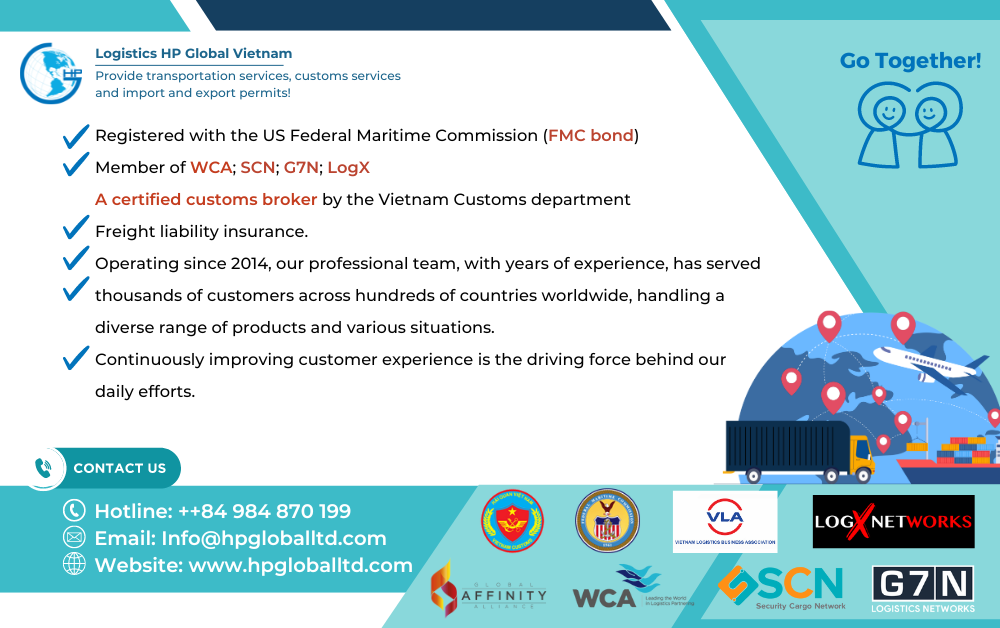
→ Contact us for freight and inbound and outbound services for shipments to/from Vietnam – Email: info@hpgloballtd.com
You may concern:
- Overview Of Trade Relations Between Vietnam And The World
- Overview of Vietnam Seaports
- Import Cosmetics to Vietnam: Procedure and Duty
For consultation and quotation for cargo import to and export from Vietnam, contact us as below details
Logistics HP Global Vietnam
Freight forwarder, Customs Broker and Vietnam Import/export license
Building No. 13, Lane 03, N003, Van Khe, Ha Dong, Hanoi
Website: hpgloballtd.com / hptoancau.com
Email: info@hpgloballtd.com
Phone: ++84 24 73008608 / Hotline: ++84 984870199/ ++84 8 8611 5726
Note:
– The article is for reference only, prior to using the content, it is suggested that you should contact HP Global for whether any update
– HP Global keep it full right copy right of the article. No copy for commercial purpose is approved.
– Any copy without approval by HP Global (even note quote from website hpgloballtd.com/hptoancau.com) can cause to our claim to google and related agencies.
 Tiếng Việt
Tiếng Việt  English
English  简体中文
简体中文 
